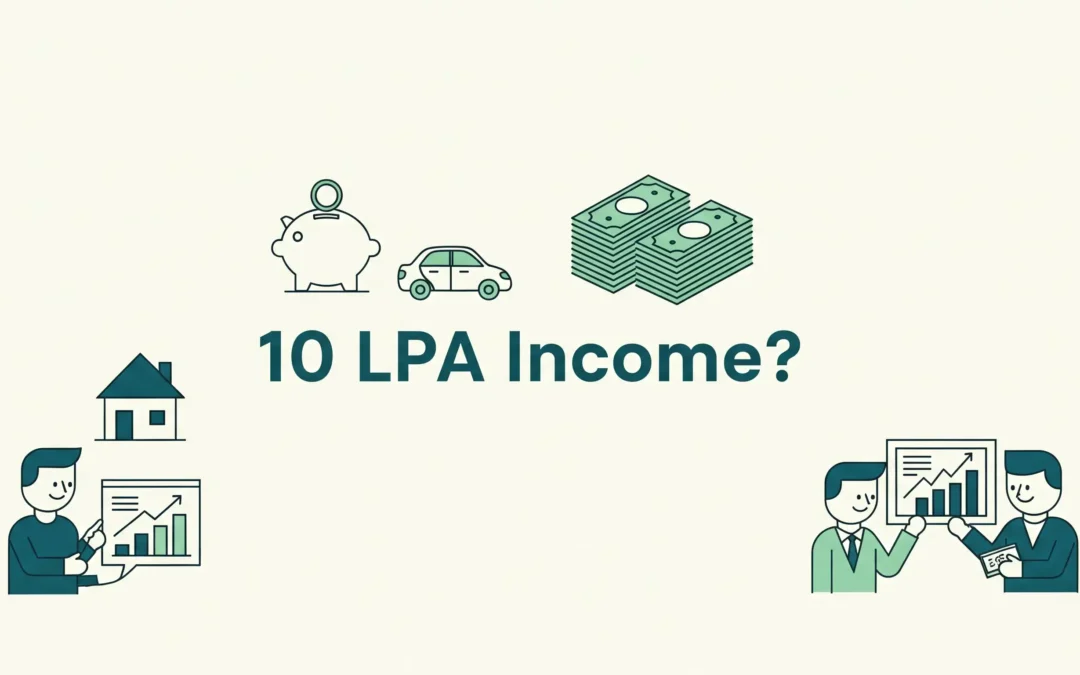Individuals may face difficulties at the start of their careers in managing their salaries. Even after earning Rs. 10 lakhs per annum, it may feel less if not managed wisely. The confusion between CTC and take-home salary is valid. They assume that if the offer letter mentions Rs. 10 lakhs as compensation, they will receive the full amount in their bank account, which is clearly not the case.
This article will help you understand what you will receive and how you can save the maximum amount possible.
How Much Do You Really Take Home from 10 LPA?
CTC (Cost to Company) is not the same as Take-Home Pay. Even though your employer may offer you a 10 LPA package, the amount that actually reaches your account each month is much lower because of tax obligations and deductions.
The example below will help you understand better:
| Income Component | Amount (Rs. ) |
| Gross CTC | 10,00,000 |
| Standard Deduction | 50,000 |
| Professional Tax/Other Deductions | 2,500 (approx.) |
| EPF Contribution (12% of basic, consider basic of 20,000) | 2,400/month = 28,800 annually |
| Tax Payable (as per new tax regime) | 0 (after rebate under Section 87A) |
| Annual Take-Home Pay | 9,18,700 |
| Monthly Take-Home Pay | 76,558 (approximately) |
Accurate Cost Forecasting
Now that we have understood the difference between CTC and Take-home salary, let us look at the example showing a realistic breakdown of a young working professional’s monthly expenses:
| Expenses in Bangalore | Estimated Cost (Rs. ) | % of Income |
| House Rent + Utilities (WiFi, Electricity, etc.) | 18,250 | 23.85% |
| Food & Groceries | 8,150 | 10.65% |
| Transport (Fuel, Metro, Cabs) | 3,100 | 4.05% |
| EMIs (Education Loan, Laptop/Vehicle Loan) | 5,100 | 6.66% |
| Insurance Premiums | 2,550 | 3.33% |
| Shopping & Entertainment | 7,100 | 9.28% |
| Subscriptions (Netflix, OTT, Gym) | 2,450 | 3.2% |
| Total | 46,000 | 65.4% |
How to Increase Savings on a 10 LPA Income?
Let us look at ways to save as much money as you can. Saving is important, as it can be used later for emergencies, buying a car, or a house, among other purposes.
1. Applying the 50-30-20 Rule to Strategic Budgeting
One commonly used model for managing personal finances is the 50-30-20 framework:
- 50% of as Needs: Use the major part of your take-home pay for necessities like utilities, groceries, rent, insurance premiums, and transportation expenses. They come in the category of needs and are non-negotiable.
- 30%: as Wants: This amount can be used for travel, entertainment, dining out, and subscriptions, among other discretionary expenses.
- 20% is the minimum amount that should be saved and invested each month. However, if living expenses are kept to a minimum, people who want to build wealth more quickly should aim for closer to 30% to 35%.
2. Optimising Taxes to Increase Post-Tax Revenue
If you opt for the old tax regime, you can lower your tax liability by claiming deductions such as:
- Section 80C: Yearly investments of up to Rs. 1.5 lakh in options such as 5-year tax-saving FDs, PPF, EPF, ELSS, and NSC.
- Section 80D: Up to Rs. 25,000 can be deducted from health insurance premiums for both the individual and their family
- HRA and LTA: As long as the right paperwork is kept up to date, claim exemptions for House Rent Allowance and Leave Travel Allowance if you are qualified.
Note: Most of these deductions are not available under the new tax regime, except for the standard deduction.
3. Automating Investments and Savings
- Automating the saving process guarantees that savings happen regularly without being influenced by emotions, which helps combat behavioural spending tendencies.
- Establish mutual fund Systematic Investment Plans (SIPs), making sure a set sum is invested at the start of every month.
- Depending on personal risk profiles, set up auto-debit instructions for liquid funds, direct equity investments, or recurring deposits.
4. Lifestyle Control and Expense Rationalisation
Finding and cutting unnecessary expenses is necessary to maintain the momentum of savings.
- Examine fixed expenses such as premium services, gym memberships, and subscriptions. Use usage to justify.
- Make conscious choices on expensive areas, like housing, e.g., choosing shared accommodations or living in cost-effective localities.
Bottomline
The conclusion can be drawn that personal finance planning should be done based on the take-home salary rather than CTC. Following the steps like the 50:30:20 rule, choosing the right investment, understanding tax deductions, etc., will help you avoid unnecessary expenses and achieve better savings.
Freshers especially make the mistake of carelessly spending in the initial days and then regret it later. To avoid this, it is important to understand this article and implement it as well.


